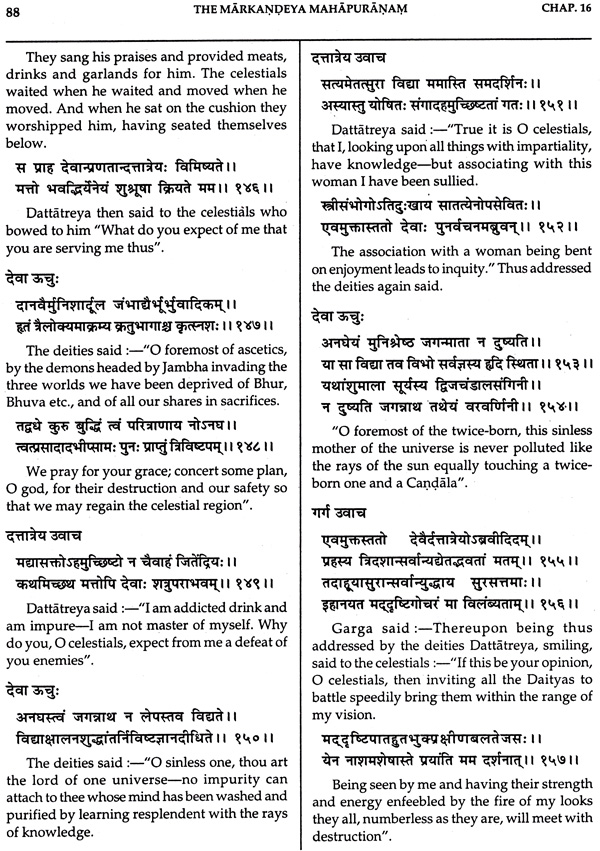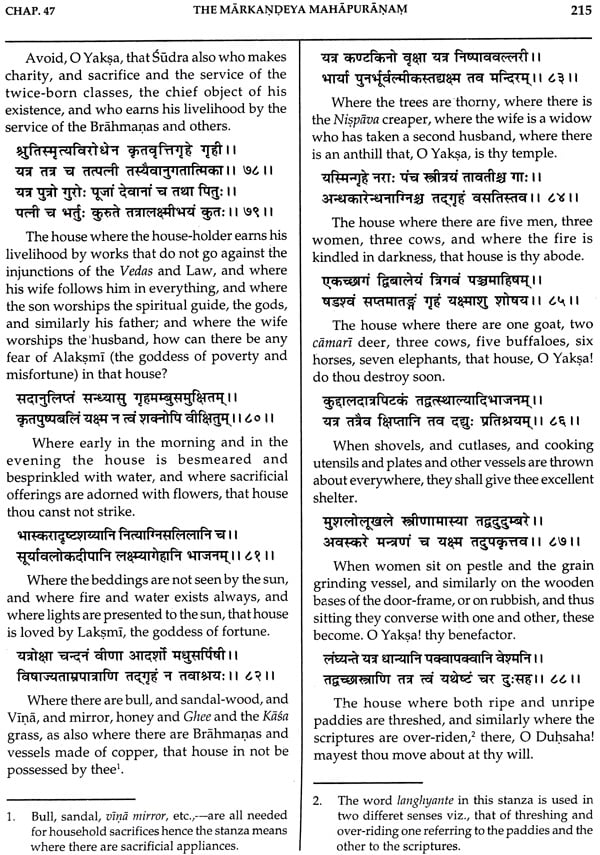
| Item Code: | NAR647 |
| Author: | Pushpendra Kumar |
| Publisher: | EASTERN BOOK LINKERS |
| Language: | Sanskrit Text With English Translation |
| Edition: | 2018 |
| ISBN: | 9788178540672 |
| Pages: | 498 |
| Cover: | HARDCOVER |
| Other Details | 10.00 X 7.50 inch |
| Weight | 1.10 kg |
The different works known by the name of Puranas (or old) are evidently derived from the mythoheroic stage of Hindu belief. The Puranas are commonly stated to be eighteen in number. It is said there are also eighteen Upa or Minor Puranas-but the names of all these are not found. The principal eighteen Puranas are Brahma, Padma, Visnu, Siva, Bhagavata, Naradiya, Markandeya, Agni, Bhavisya, Brahma Vaivarta, Linga, Varaha, Skanda, Vamana, Karma, Matsya, Garuda and Brahmanda.
All these Puranas are classed into three groups according to the qualities which prevail in them. The Matsya Purana remarks that those in which glory of Hari or Visnu prevails are Sattvika; those in which the legends of Agni of Siva pre dominate are Tamasa and those which dwell most on the stories of Brahma are Rajasa.
Markandeya Purana is classed in the same category with the Vedas and described as an immediate production from Brahma's mouth. Although a Purana it is not attributed to Vyasa who is considered as the author of all works bearing that appellation. The Markandeya does not acknowledge him as its composer, editor or compiler. It claims equal honour with the Vedas themselves.
The most important section of the episode of the Markandeya Purana is the Canclipatha : a work in very great estimation throughout India, with the votaries of the goddess Kali and other deities to whom sangunary sacrifices are offered. The title Saptagati or seven hundred is attached to it because it consists of seven hundred verses. The whole poem is a detail of the actions and transfiguration of the goddess during her dreadful combats with the demons and dark spirits for the mastery of the universe, which ends with the goddess annihilating their power and restoring the vanquished gods to their respective dominions.
The Markancleya Puraria has a character quite different from that of the other Purapas. It is entirely shorn of that Purarias. There are rarely to be seen prayers and invocations to any deity. Its leading feature is narrative and it abounds in a number of beautifully written legends.
With the publication of this important Purana alongwith English translation from a rare book by Manmatha Nath Dutta will help the scholars and the devotees as well.
The different works known by the name of Puranas (or old) are evidently derived from the mytho-heroic stage of Hindu belief. They deal with five characteristic topics, which, as Mr. Colebrooke mentions are 1. Primary creation, 2. Secondary creation, 3. The Genealogy of gods and patriarchs, 4. Reigns of the Manus and 5. History or such particulars as have been preserved of the princes of the solar or lunar races and of their descendants to modern times. Siva and Visnu, under one or other form, are almost the sole objects that claim homage of the Hindus in the Puranas. These are the characteristics of the Puranas as given by Amar Sinha, the great lexicographer. But the Puranas, which we see in the present, do not conform to this description. The reason is not far to seek. There has been a considerable addition of subject matter in the shape of interpolation. Sanskrit scholars in India never cared for their own name. But to preserve what is considered by one as his best production in letters is a human instinct. Thus we find fine literary compositions, emanting from the pens of Sanskrit Pandits, time to time shelved in the bulk of great literary works. These interpolations in the original body of a work, made at different periods, present it to us as a completely different book. It is for this reason we find so many heterogeneous things in old Sanskrit works. Whatever may be the value of the Puranas as a history or a record of the knowledge of the ancient Hindus their importance as books of religious instruction is undoubtedly very great.
The invariable form of the Puranas is that of a dialogue in which some person relates its contents in reply to the enquiries of another. This dialogue is interwoven with others which are repeated as having been held on other occasions between different individuals. The immediate narrator is commonly Lomaharsana, the disciple of Vyasa who is supposed to communicate what was imparted to him by his preceptor.
The Puranas are commonly stated to be eighteen in number. It is said there are also eighteen Upa or Minor Puranas-but the names of all these are not found. The principal eighteen Puranas are Brahma, Padma, Visnu, Saiva, Bhagavat, Naradiya, Markandeya, Agni, Bhavisya, Brahma Vaivarta, Linga, Varaha, Skanda, Vamana, Karma, Matsya, Garuda and Brahmanda.
All these Puranas are classed into three groups according to the qualities which prevail in them. The Matsya Purana remarks that those in which glory of Hari or Visnu prevails are Sattvika; those in which the legends of Agni of Siva predominate are Tamasa and those which dwell most on the stories of Brahma are Rajasa. Truly does professor Wilson remark that the Rajasa Purarias lean to the Sakta division of the Hindus, the worshippers of Sakti or the female principle.
Ranking seventh in the list of the Mahapurarias the Markandeya Puriina, is one of the most important, interesting and probably one of the oldest works. Its recitation frees one from the taints of sin. It was named after the sage Markandeya, who acquired its knowledge from Brahma, the creator of the universe. Once Jaimini, the author of the Mimarhsa Sutras, approached him with a request to instruct him on four questions. The holy sage Markandeya directed him to the four celestial Birds that were well-versed in the Sastras, for answering his questions concerning a religious enigma, a social perplexity, a moral incongruity, and a violation of natural justice.
Summing up the general character of this Purana which hardly applies to the Devi Mahatmya Prof. H.H. Wilson says, "This Purana has a character different from that of all the other Maha Purarias. It has nothing of a sectarial spirit, little of a religious tone : rarely inserting prayers and invocations to any deity, and such as are inserted are brief and moderate. It deals little in precepts, ceremonial or moral. Its leading feature is narrative, and it presetns an uninterrupted succession of legends, most of which when ' ancient are embellished with new circumstances. It is designed to recommend no special doctrine or observance. Whether they are derived from any other source or whether they are original inventions, it is not possible to ascertain. They are most probably for the greater part at least original; and the whole has been narrated in the compiler's own manner; a manner superior to that of the Mafia Purartas in general with only exception of the Bhagavata Purana."
The Markandeya Purana has come down to us in three editions, published at Bombay, Poona and Calcutta. It is difficult to answer which edition comes closest to the arche-type of Markandeya. The Calcutta edition ends abruptly in chapter 136, leaving 'Dama' acquiescing tamely in the fight of his father's murderer, Vapusmat. The other version is found in the Bombay and the Poona editions and carries the story on till ' dama' takes vengeance on Vapusmat. Dr. K.M. Banerjee considered that the abruptness and incompleteness were strong evidences of the genuineness of the concluding of the Calcutta edition. But Prof. F.E. Pargiter considered the concluding of the other editions as more authentic. The Markandeya Purana consists of nine thousand verses, spread over one hundred and thirty seven chapters.
There are three definite stages in the development of the Markandeya Purana. First stage is represented by the chapters from 43-81 and 93-136. These chapters constituted the Purana in its original shape as the Markandeya Purana. The name would imply that originally Markandeya was the chief figure. It is only in this part that he appeared as the real teacher. Here Markandeya declared that he heard it when Daksa related it. He further informed the sages that the Markandeya Purana was equal to the Vedas and had likewise sprang from the mouth of Brahma. These words clearly exhibit the true beginning of the Purana.
In the second stage chapters from 1-42 were composed.
**Contents and Sample Pages**
















Send as free online greeting card
